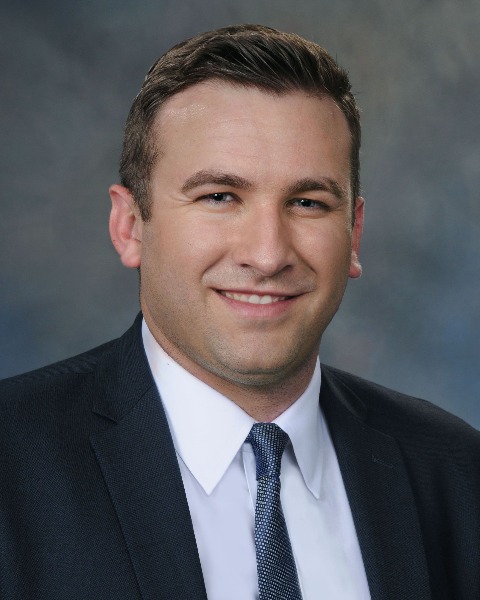Back
Neonatal/Infant Resuscitation
Category: Abstract Submission
Neonatal/Infant Resuscitation II
490 - Ultrasound Diagnosis of Discordant Congenital Diaphragmatic Hernia in Twins in the Delivery Room
Saturday, April 23, 2022
3:30 PM – 6:00 PM US MT
Poster Number: 490
Publication Number: 490.231
Publication Number: 490.231
Sean M. Cullen, New York Presbyterian/ Weill Cornell Medicine, New York, NY, United States; Ericalyn Kasdorf, Weill Cornell Medicine, New York, NY, United States; Sara Cohen, Weill Cornell Medicine, new york, NY, United States; Arzu Kovanlikaya, Weill Cornell Medicine, New york, NY, United States; Brittany J. Roser, Weill Cornell Medicine, New York, NY, United States; Corrina Oxford-Horrey, Weill Cornell Medicine, New York, NY, United States; Cynthia Perez, New York Presbyterian Weill Cornell Medicine, New York, NY, United States; Catherine Chang, Weill Cornell Medicine, New York, NY, United States

Sean M. Cullen, MD/PHD (he/him/his)
Fellow
Weill Cornell Medicine
New York, New York, United States
Presenting Author(s)
Background: Most infants with prenatally diagnosed congenital diaphragmatic hernia (CDH) are intubated rapidly after birth to optimize oxygenation/ventilation and avoid abdominal distention. Diagnosis is later typically confirmed by chest radiograph (CXR). In rare cases of discordant CDH in twin pregnancies with an absence of external distinguishing markers (similar weights, presentation, and sex), it may be difficult to quickly determine which twin has CDH in the delivery room (DR). In these instances, a CXR cannot be obtained quickly enough to make real time management decisions. Thus, conflict arises surrounding whether immediate intubation of both twins should be performed to optimize care of the twin with CDH, at the potential costs to the other twin without CDH. Rapid identification of the presence/absence of CDH in the DR utilizing ultrasound (US) may allow individualized care. This practice has not been previously described and the length of time to make the diagnosis is unclear.
Objective: Develop and implement a DR algorithm using US to rapidly diagnose presence/absence of CDH in twins with discordant CDH and absence of external identifying markers.
Design/Methods: A multidisciplinary team including obstetrics, maternal-fetal medicine, neonatology, and pediatric radiology, was assembled to attempt rapid US diagnosis of CDH at a twin delivery. A resuscitation algorithm was created incorporating radiology into the care of the newborns, prioritizing patient needs over awaiting radiologic diagnosis (Fig. 1). In situ simulation drills were held to review the algorithm, rehearse responses to possible scenarios, and streamline timing/performance with the team members/equipment present at the delivery.
Results: An elective cesarean section was performed at 37 weeks gestational age. Absence of CDH was announced in twin A 45 seconds after delivery, with US diagnosis made in 19 seconds (Fig. 2). The infant received routine postnatal care, was transferred to the well baby nursery, and discharged with mother on day of life (DOL) four. Twin B was diagnosed with CDH at 47 seconds of life (US diagnosis made in 14 seconds), intubated by 68 seconds of life, stabilized and transferred to the NICU. Twin B underwent operative repair on DOL 3, was extubated on DOL 7, and weaned off respiratory support by DOL 13.Conclusion(s): A delivery room algorithm utilizing US can help rapidly diagnose presence/absence of CDH in twins immediately after birth. Use of US allowed tailored care of both babies and did not delay the performance of necessary interventions in the twin with CDH.
Resuscitation Algorithm and Personnel PositioningFigure 1.jpeg
Discordant CDH Twin Delivery Timeline and US findingsFigure 2.jpegDetailed delivery timeline for Twin A & B with representative sagittal US of left chest images from both twins, and a transverse midline view of chest from Twin B. US structure abbreviations as follows: D (diaphragm), H (heart), L (lung), R (rib), S (Stomach), Sm (collapsed small bowel loops), Sp (spleen), St (sternum).
Objective: Develop and implement a DR algorithm using US to rapidly diagnose presence/absence of CDH in twins with discordant CDH and absence of external identifying markers.
Design/Methods: A multidisciplinary team including obstetrics, maternal-fetal medicine, neonatology, and pediatric radiology, was assembled to attempt rapid US diagnosis of CDH at a twin delivery. A resuscitation algorithm was created incorporating radiology into the care of the newborns, prioritizing patient needs over awaiting radiologic diagnosis (Fig. 1). In situ simulation drills were held to review the algorithm, rehearse responses to possible scenarios, and streamline timing/performance with the team members/equipment present at the delivery.
Results: An elective cesarean section was performed at 37 weeks gestational age. Absence of CDH was announced in twin A 45 seconds after delivery, with US diagnosis made in 19 seconds (Fig. 2). The infant received routine postnatal care, was transferred to the well baby nursery, and discharged with mother on day of life (DOL) four. Twin B was diagnosed with CDH at 47 seconds of life (US diagnosis made in 14 seconds), intubated by 68 seconds of life, stabilized and transferred to the NICU. Twin B underwent operative repair on DOL 3, was extubated on DOL 7, and weaned off respiratory support by DOL 13.Conclusion(s): A delivery room algorithm utilizing US can help rapidly diagnose presence/absence of CDH in twins immediately after birth. Use of US allowed tailored care of both babies and did not delay the performance of necessary interventions in the twin with CDH.
Resuscitation Algorithm and Personnel PositioningFigure 1.jpeg
Discordant CDH Twin Delivery Timeline and US findingsFigure 2.jpegDetailed delivery timeline for Twin A & B with representative sagittal US of left chest images from both twins, and a transverse midline view of chest from Twin B. US structure abbreviations as follows: D (diaphragm), H (heart), L (lung), R (rib), S (Stomach), Sm (collapsed small bowel loops), Sp (spleen), St (sternum).
